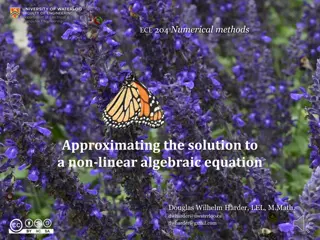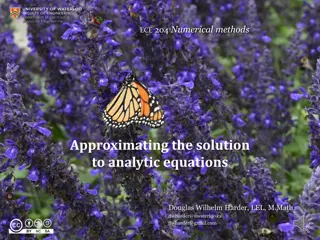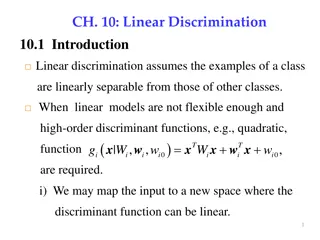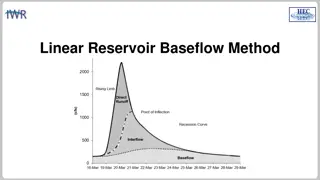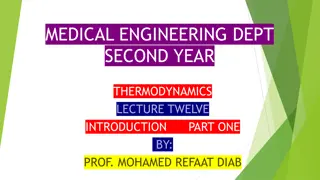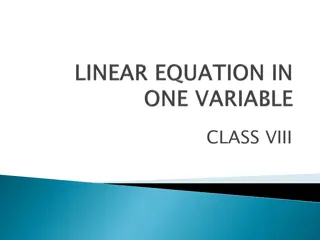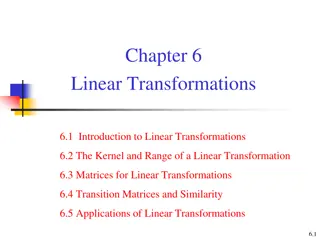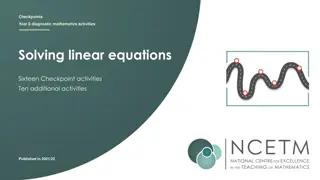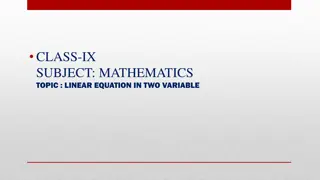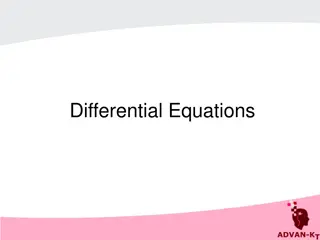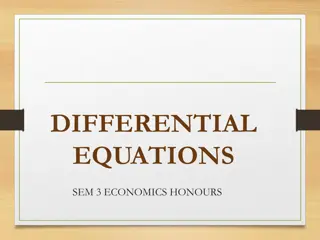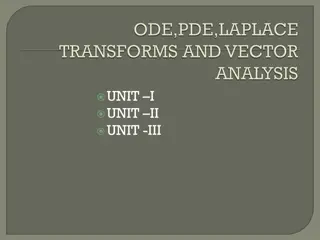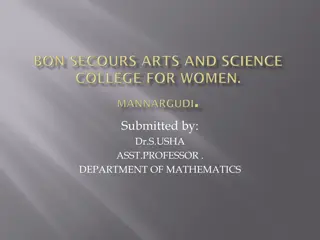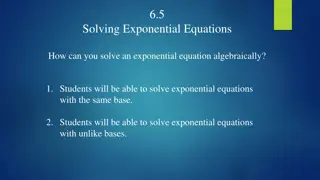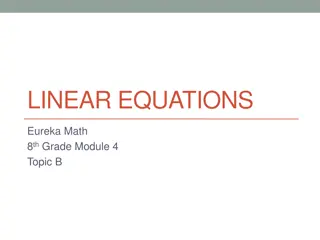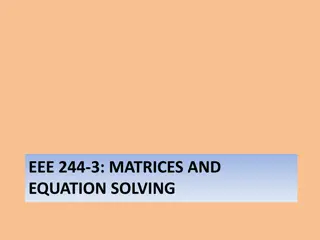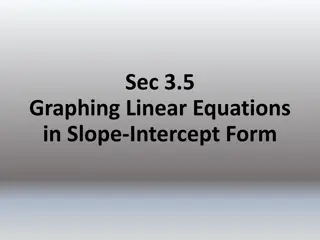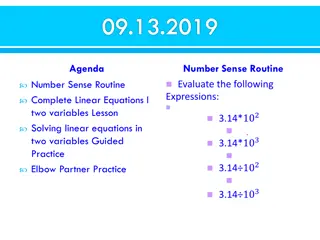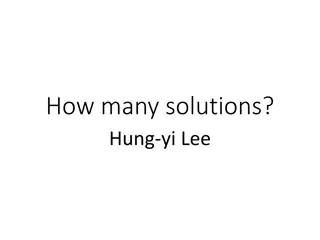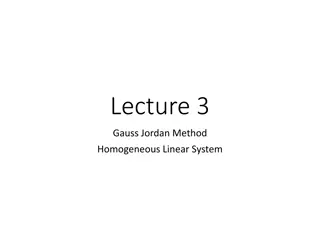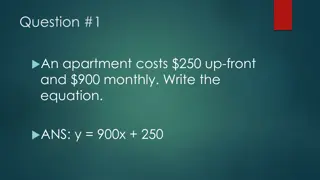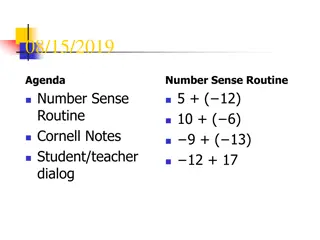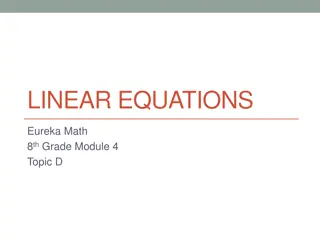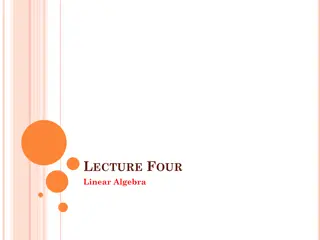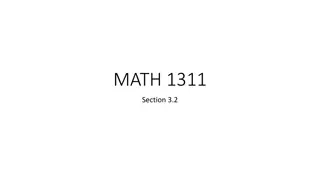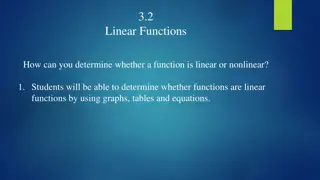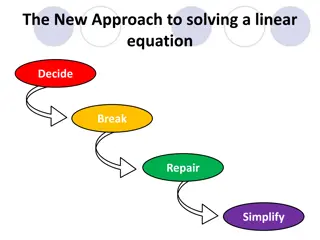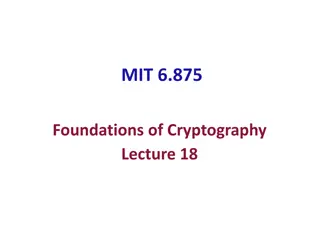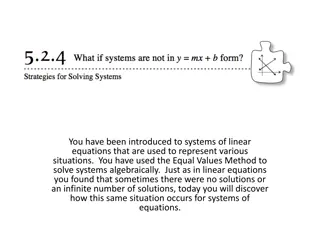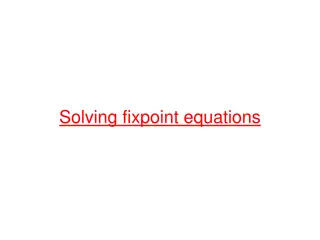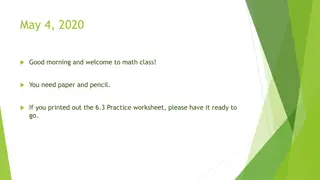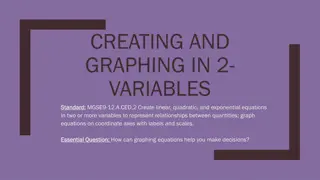Approaches for Approximating Non-Linear Equations
Techniques for approximating solutions to non-linear algebraic equations involve converting the problem into a root-finding one. Seven methods such as Newton's method, bisection method, and linear interpolation are utilized with specific halting conditions. Tangent and secant lines, as well as Taylo
4 views • 13 slides
Numerical Methods for Approximating Analytic Equations
Introduction to approximating solutions to analytic equations, focusing on differential equations, integral equations, and integro-differential equations. Exploring ordinary and partial derivatives, differential and integral equations, and the involvement of unknown functions and their derivatives a
4 views • 15 slides
Linear Discrimination for Classification
Linear discrimination is a method for classifying data where examples from one class are separable from others. It involves using linear models or high-order functions like quadratic to map inputs to class separable spaces. This approach can be further categorized as class-based or boundary-based, e
3 views • 37 slides
Linear Reservoir Baseflow Method
The linear reservoir baseflow method utilizes linear reservoirs to simulate the movement of water infiltrated into the soil. This method models water movement from the land surface to the stream network by integrating a linear relationship between storage and discharge. Users can select from one, tw
0 views • 11 slides
Maxwell Equations in Thermodynamics
In thermodynamics, Maxwell equations are derived using Euler's reciprocity relation. They involve characteristic functions such as internal energy, free energy, enthalpy, and Gibbs free energy, along with parameters like temperature, entropy, pressure, and volume. These equations form the foundation
1 views • 15 slides
Differential Equations of First Order & Higher Degree: Lecture 18
This lecture covers differential equations of first order but not of the first degree, general forms of such equations, methods for solving them, and examples of differential equations to be solved. The content includes detailed explanations, equations, solutions, and problem-solving techniques.
0 views • 9 slides
Linear Equations in Algebra: A Comprehensive Overview
An exploration of algebraic expressions, equations, and linear equations in one variable with detailed explanations and examples. Discover the fundamental concepts, solving methods, and applications of linear equations in various word problems. Master the art of transforming mathematical expressions
0 views • 15 slides
Linear Transformations and Matrices in Mathematics
Linear transformations play a crucial role in the study of vector spaces and matrices. They involve mapping vectors from one space to another while maintaining certain properties. This summary covers the introduction to linear transformations, the kernel and range of a transformation, matrices for l
1 views • 85 slides
Linear Equations Checkpoint Activities for Year 8 Students
This diagnostic mathematics resource for Year 8 students focuses on solving linear equations through a series of Checkpoint and additional activities. Published in 2021/22, the content covers topics such as representing equations with algebra and solving for unknown variables. Students will engage w
0 views • 47 slides
Learning Linear Equations in Two Variables
Understanding linear equations in two variables is essential for solving real-life problems. This topic covers the definition, solution, and graphical representation of such equations, helping students connect mathematical concepts to practical scenarios. By learning to write and solve linear equati
3 views • 31 slides
Differential Equations: Types, Classification, and Solutions
Differential equations are mathematical equations that relate independent and dependent variables through differential coefficients. They can be classified as ordinary or partial, based on the types of derivatives involved. The order and degree of a differential equation, as well as its linearity an
4 views • 26 slides
Differential Equations in Economics Honours
Differential equations, introduced by Newton and Leibniz in the 17th century, play a key role in economics. These equations involve derivatives and represent implicit functional relationships between variables and their differentials, often related to time functions. The order and degree of a differ
1 views • 16 slides
Introduction to Differential Equations and Laplace Equations
Understanding differential equations of various orders, solving methods, linear and non-linear equations, ordinary and partial differential equations, definitions of solutions, and general vs. particular solutions in the context of Differential Equations and Laplace Equations.
4 views • 20 slides
Differential Equations: Basics to Applications
Differential equations are fundamental in mathematics, with various types such as first-order, partial, and Clairaut's equations explored in this content. The content covers general equations, solutions, and examples, providing insights into linear and higher-order equations with constant coefficien
0 views • 20 slides
Partial Differential Equations of Second Order
Exploring the concepts of second-order partial differential equations in mathematics, including the general form, linear equations with variable coefficients, and equations with constant coefficients. Learn about integral solutions, examples, and techniques for solving these equations with detailed
0 views • 21 slides
Comprehensive Overview of Numerical Linear Algebra Methods for Solving Linear Systems
Explore numerical linear algebra techniques for solving linear systems of equations, including direct and iterative methods. Delve into topics like Gaussian elimination, LU factorization, band solvers, sparse solvers, iterative techniques, and more. Gain insights into basic iterative methods, error
6 views • 12 slides
Solving Exponential Equations Algebraically
Learn how to solve exponential equations algebraically with the same base and unlike bases. Understand the properties of equality for exponential equations and practice solving various equations step by step. Improve your skills in rewriting equations with the same base and applying the rules of exp
0 views • 9 slides
Linear Equations in Real-Life Scenarios
Explore the concept of linear equations through real-life examples involving distance, speed, time, and constant rates. Practice solving problems to determine distances covered, areas mowed, and volumes of water coming out of a faucet over specific periods. Engage in workshops and assessments to rei
0 views • 27 slides
Matrices and Solving Equations in Electrical Engineering
Matrices play a crucial role in solving linear equations in Electrical Engineering applications. Learn about matrix structures, special matrices, inverses, transposes, system of linear equations, and solving methods using MATLAB/Python. Explore the application of matrices in solving voltage-current
2 views • 24 slides
Linear Equations and Graphs
Exploring linear equations in slope-intercept form, the concept of slope, graphing techniques, and real-world applications. Learn about positive and negative slopes, horizontal and vertical lines, slope-intercept form, and interpreting graphs. Examples guide you through finding slope, graphing lines
1 views • 8 slides
Solving Linear Equations and Inequalities in Two Variables
Learn how to solve linear equations and inequalities in two variables by graphing them on a coordinate plane. Understand the steps for graphing inequalities, including determining solid or dashed lines and shading above or below the line. Explore examples and tips for shading regions correctly to fi
0 views • 25 slides
Linear Equations in Two Variables
Explore linear equations in two variables, solving systems of equations, graphing solutions, and determining types of solutions. Learn how to analyze and find solutions graphically, identify infinite solutions, no solutions, and unique solutions, and understand the concept of dependent systems. Disc
1 views • 35 slides
Linear Dependent and Independent Vectors
In linear algebra, when exploring systems of linear equations and vector sets, it is crucial to distinguish between linear dependent and independent vectors. Linear dependence occurs when one vector can be expressed as a combination of others, leading to various solutions or lack thereof in the give
0 views • 20 slides
Gaussian Elimination and Homogeneous Linear Systems
Gaussian Elimination is a powerful method used to solve systems of linear equations. It involves transforming augmented matrices through row operations to simplify and find solutions. Homogeneous linear systems have consistent solutions, including the trivial solution. This method is essential in li
0 views • 16 slides
GCSE Algebra Revision Materials and Equations Practice
Explore a collection of GCSE algebra revision materials, including solving linear equations and common mishaps in algebraic simplification. Practice setting up equations and solving linear equations with provided examples and questions. Enhance your algebra skills through comprehensive content desig
0 views • 15 slides
Converting Left Linear Grammar to Right Linear Grammar
Learn about linear grammars, left linear grammars, and right linear grammars. Discover why left linear grammars are considered complex and how right linear grammars offer a simpler solution. Explore the process of converting a left linear grammar to a right linear grammar using a specific algorithm.
0 views • 44 slides
Linear Equations and Relationships
Explore various questions related to linear equations, slopes, y-intercepts, proportional relationships, and unit rates with step-by-step solutions and explanations. Practice identifying linear functions and graphing equations through real-life scenarios. Enhance your understanding of slope-intercep
0 views • 16 slides
Linear Equations: Basics and Examples
This content covers the basics of linear equations, including their standard form Ax + By = C and how to identify them. It also discusses examples of linear and nonlinear equations, x and y-intercepts, and how to find them. The visual aids and explanations provided make it easier to grasp these fund
0 views • 18 slides
Linear Equations in 8th Grade Math
Dive into Module 4, Topic D of Eureka Math's 8th-grade curriculum focusing on linear equations. The lesson covers systems of equations, solving problems involving constant speeds, and practicing linear equation concepts. Explore examples, workshops, and more to enhance your understanding of this fun
0 views • 49 slides
Linear Algebra Concepts: Systems of Equations, Orthogonal Matrix, and Quadratic Forms
Explore the concepts of simultaneous linear equations, homogeneous and non-homogeneous systems, orthogonal matrices, and various types of quadratic forms in linear algebra. Learn about the characteristics of positive definite, semi-positive definite, and negative definite quadratic forms represented
0 views • 7 slides
Linear Functions in Mathematics
Linear functions play a crucial role in mathematics, focusing on elements like rate of change and initial value. Through examples involving daily car rental costs and profit from selling birdhouses, this content explores the concept of linear functions and how they are applied in real-life scenarios
0 views • 13 slides
Determining Linearity of Functions Through Graphs, Tables, and Equations
Students learn to distinguish between linear and nonlinear functions by examining graphs, tables, and equations. Linear functions exhibit constant rates of change, represented by straight lines, while nonlinear functions lack a constant rate of change, leading to curved or non-linear graph shapes. B
0 views • 11 slides
New Approach to Solving Linear Equations: Deciding, Breaking, Repairing, Simplifying
In the new approach to solving linear equations, the process involves deciding on the steps to take, breaking down the equation, repairing any mistakes, and simplifying to find the solution. Illustrations guide you through each step, from decision-making to final resolution. The method aims to make
0 views • 69 slides
Real-Life Applications of Algebra Through Linear Equations
Dive into the practical application of algebra in everyday situations by understanding how to compare costs using linear equations. Discover the concept of systems of linear equations and how they can help you make informed decisions on the best value. Learn about consistent, inconsistent, and coinc
0 views • 45 slides
Introduction to Lattice-Based Cryptography and Linear Equations Solving
Explore the fundamentals of lattice-based cryptography and the significance of solving linear equations in cryptography. Learn about the exponential hardness and quantum resistance of lattice-based crypto, as well as the challenges and techniques involved in solving linear equations with various str
2 views • 29 slides
Solving Systems of Linear Equations: Methods and Applications
Explore various methods for solving systems of linear equations, including the Equal Values Method and solving by inspection. Work through examples involving plant growth rates, job application tests, messy fractions, and more. Understand how to compare coefficients, constants, and graph equations t
0 views • 9 slides
Fixpoint Equations in Programming Languages
Fixpoint equations play a crucial role in programming languages for solving mutually recursive problems like parsing and dataflow analysis. This content explores the concepts of fixpoint equations, assumptions for ensuring solutions, computing solutions, and generalizations for cases with greatest e
0 views • 31 slides
Linear and Nonlinear Functions in Mathematics
Explore the concepts of linear and nonlinear functions in mathematics through identifying linear and nonlinear functions from graphs, understanding the characteristics of linear functions, and identifying linear functions from tables. Learn about the constant rate of change, slope, and how to determ
0 views • 49 slides
Linear Equations in Jeopardy Style
Delve into the world of linear equations with this interactive Jeopardy game! Test your knowledge on topics such as point-slope form, x- and y-intercepts, and calculating slopes. From identifying equations based on graphs to solving linear equations, this engaging presentation offers a fun and educa
0 views • 27 slides
Equations in Two Variables
Explore the creation and graphing of linear equations in two variables to represent relationships between quantities. Understand the concept of slope, y-intercept, and the slope-intercept form of equations. Practice creating tables of values, writing algebraic equations, and graphing on coordinate a
0 views • 22 slides
